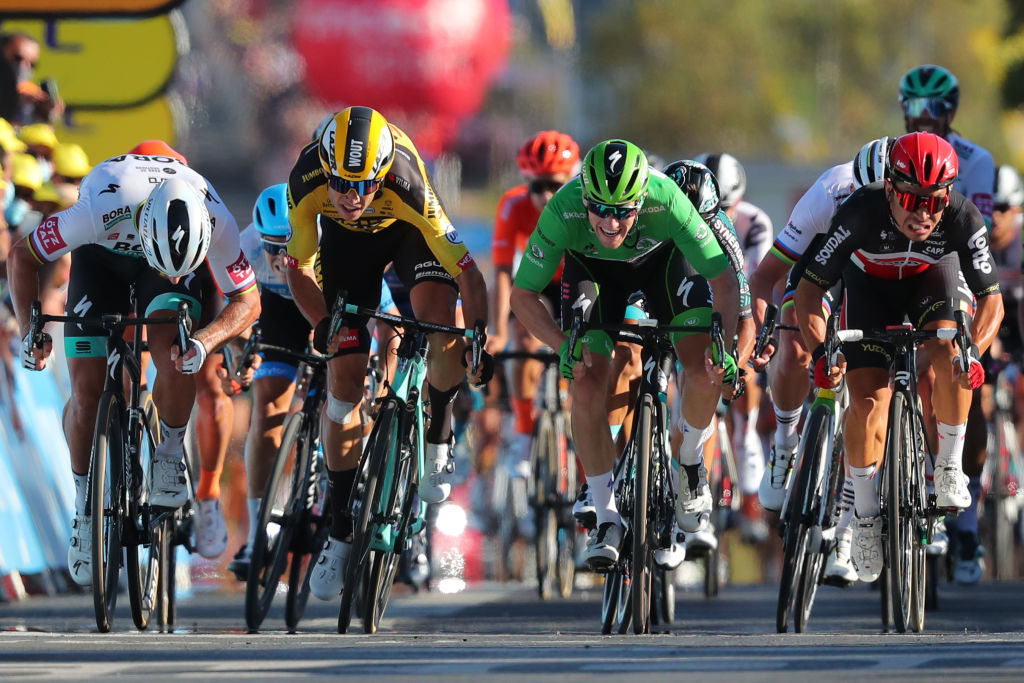Bos proposes UCI adopt track-like rules to make road sprinting safer
Five-time track world champion suggests no-passing zones in final 300 metres

Five-time track world champion and former WorldTour road racer Theo Bos laid out an intriguing proposal to make road sprinting safer by instituting some rules adapted from the track.
"It must change," Bos told AD.nl, "No more wild west in the bunch sprints, with officials interpreting it only a little loosely, but few rules that everyone understands and that everyone can enforce."
2020 had several alarming incidents including the horrifying crash of Fabio Jakobsen in the Tour of Poland, for which Dylan Groenewegen has been given a nine-month ban. The Jumbo-Visma rider deviated from his line to cut off Jakobsen and admitted fault, but other riders were quick to also place blame on the race organisers and UCI for the insufficient barriers that collapsed and exacerbated Jakobsen's injuries.
The terror of that incident did not stop the aggressive antics in bunch sprints in the shortened late-2020 season: Pascal Ackermann barged a rider in the Scheldeprijs causing a crash, Peter Sagan was relegated for a shoulder charge on Wout van Aert in a sprint during the Tour de France, while Sam Bennett clashed twice with Emils Liepins in a stage of the Vuelta a España, earning a disqualification, and Jolien D'hoore ran Lorena Wiebes into the barriers and lost her victory in the Driedaagse Brugge-De Panne.
Bos says that with a few simple rules, sprinting can be safer. He proposes that a narrow strip of pavement along the edge of the barriers be made into the equivalent of the sprinter's zone on the track. There would be no passing allowed inside that zone within the last 300m of the sprint. The rider in the lead in the sprint zone cannot leave it.
"This prevents riders from swerving all over the road - sprinters, but also lead-outs," Bos said. "If you are at the head of the peloton at 300 meters in the sprinters' section, then you stay there. Leaving gets you relegated. If you overtake riders from behind, you are allowed to leave the box, otherwise you cannot pass in it."
Similarly, passing inside along the barriers would be prohibited, "So you can no longer dive into small holes, like Sagan in the Tour. But you also no longer get the situation that the front rider slams the door - with all the consequences that entails. Anyone who passes between the rider and the barriers in the sprinters section will be relegated."
Get The Leadout Newsletter
The latest race content, interviews, features, reviews and expert buying guides, direct to your inbox!
Bos also recommends further safety measures, ensuring that the final 300 metres of any sprint is straight, that it is lined with two-metre high barriers so fans cannot hang over them and the barriers must be flush with the ground, with no protruding feet.
He also suggests putting a line down the middle of the road so that sprinters have a point of reference to know they're sprinting straight ahead, and proposes that riders not be allowed to dart from the barrier zone across the centre line, similar to the keirin where crossing two lines earns a disqualification.
UCI jury member Joey Ermens told AD.nl that Bos makes some good points, but that two-metre fencing is probably impractical for most organisers.
"It's good that these kinds of proposals are coming. I think it is important to involve the race organizers as they play an important role in the success of the initiative," Ermens said.
"I think Theo makes a good point regarding the last 300 metres being straight, although it will have to be described in more detail what the dimensions of a straight road are exactly.
"Lines on the road can provide support to the rider and to the UCI commissioners to determine whether the sprint is going in a straight line. The straight line is important to me, but the focus is on hindering and endangering others."
Bos agrees that the suggestion would be a big change and it would take time for sprinters, officials and fans to get used to it.
"But it is a lot clearer this way. It also works on the track. Every youth cyclist learns as soon as he or she starts racing on the track, there is rarely any bullshit."
Een van zijn voorstellen is om lijnen op de weg aan te brengen en een deel van de regels op de baan over te brengen naar de weg. pic.twitter.com/wHs1QtjcAPDecember 2, 2020
Cyclingnews is the world's leader in English-language coverage of professional cycling. Started in 1995 by University of Newcastle professor Bill Mitchell, the site was one of the first to provide breaking news and results over the internet in English. The site was purchased by Knapp Communications in 1999, and owner Gerard Knapp built it into the definitive voice of pro cycling. Since then, major publishing house Future PLC has owned the site and expanded it to include top features, news, results, photos and tech reporting. The site continues to be the most comprehensive and authoritative English voice in professional cycling.